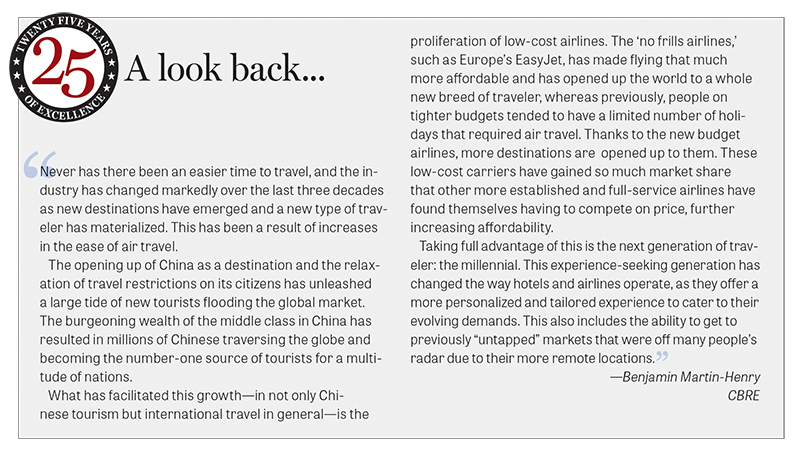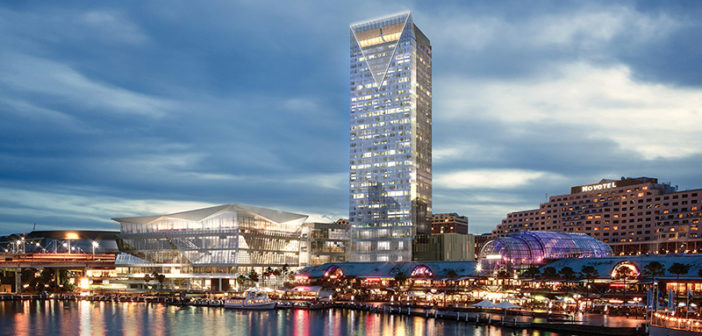AUSTRALIA—The Australian hotel market is continuing to put up strong performance figures, a direct result of record international visitor growth throughout the country.
According to a recent research report released by CBRE Research, the Australian hotel market is performing strongly: occupancy rates, ADR and RevPAR increased for the year ending March 2017 (the research firm used data compiled by STR). Compared to the year prior, occupancy levels increased 1.1%, hitting 75.8%; ADR rose 1.2% to $185; and RevPAR increased by 2.3% to $140.
Both Canberra and Adelaide outperformed the majority of other cities in the country in the first quarter of 2017. For the year ending March 2017, Canberra saw an increase in occupancy of 3.2%, giving it a boost to 75.9%; ADR in the city rose by 2.9%; and RevPAR grew by 6.2%. During the same period, Adelaide’s ADR grew 1.4% to $151; occupancy increased 3.5% to 78.1%; and RevPAR grew by 4.9% to $118. Success can be attributed to stable supply chains and increasing visitation from domestic and international tourists (both cities were in the middle of the pack in 2016).
“Adelaide and Canberra had stable supply in 2016 because there was a limited number of new hotels coming to the market due to large growth in the previous couple of years,” explained Benjamin Martin-Henry, research manager at CBRE. “Not a lot of developers saw much strength in the markets so they were reluctant to build until signs of growth became apparent. As to why tourists decided to visit these two cities, I’m not so sure, other than to say both economies have seen recent improvements, which tends to drive corporate travel.”
Currently, there doesn’t seem to be any Australian markets following the growth paths of Adelaide and Canberra; however, Martin-Henry expects Brisbane and Perth (to a lesser extent) to follow in their footsteps within the next couple of years or so. “Generally speaking, hotel markets take time to absorb new supply, so they are likely to experience stabilization or compression when large amounts of supply hit the market,” he said.
About 1,563 miles north of Canberra, Cairns, a major city on the east coast of Far North Queensland, is continuing its recent run of strong performance—posting double-digit annual RevPAR growth of 10% (reaching $119 per night). Occupancy, now at 83.6%, grew 2.6%, while ADR grew by 7.8% to $140 per night. The 14th-most-populous city in Australia is showing signs of having peaked, however. The city hasn’t seen a new hotel in nearly 20 years, but things are changing, particularly due to the city’s strong performance.
“By Cairns peaking, I mean that I don’t expect the growth rates to be as fast as they have been over the preceding two years,” he said. “There won’t be any reduction in rates or occupancy, just a slowing down in their pace of increase. What we are seeing is that occupancy growth rates are starting to level out, which will be followed by a similar leveling out in room rate growth. Given the limited supply growth projected in Cairns, it’s highly unlikely the market will see a slowdown for a good number of years. This limited supply and strong tourism growth are the reasons for the strong growth Cairns has experienced over the years.”
 As far as other markets peaking, Martin-Henry believes Hobart, the most populous city of the Australian island state of Tasmania, will “struggle to absorb its new supply.” Melbourne, the second-largest city in the country, is another market to watch for signs of limited growth (it’s struggling to consistently increase room rates, according to CBRE).
As far as other markets peaking, Martin-Henry believes Hobart, the most populous city of the Australian island state of Tasmania, will “struggle to absorb its new supply.” Melbourne, the second-largest city in the country, is another market to watch for signs of limited growth (it’s struggling to consistently increase room rates, according to CBRE).
More than $8 billion is expected to be invested in hotel development (a record), according to Tourism Accommodation Australia (TAA), a lobbying group dedicated to representing the needs of the country’s accommodations industry. Figures released by the TAA identify 288 hotel projects (34,702 rooms) under construction, approved for development or in advanced planning stages in the six state capitals, as well as Darwin.
Recently announced hotel developments include Marriott International’s Luxury Collection Hobart and IHG’s Holiday Inn Sydney Central. One of the more notable openings in 2016—the Crown Towers Perth—is Australia’s most expensive hotel development (built at a cost of $650 million with 500 guestrooms and villas).
Why the massive new investment in hotel development in the land Down Under? Simply put, the country is continuing to experience record international visitor growth. TAA’s most recent International Visitor Survey (IVS) revealed 11% growth in visitor arrivals for 2016 (bringing the total number to 7,624,665).
“International tourism growth has been fueled in the past five years by a number of factors, but arguably the most important has been air access,” explained Carol Giuseppi, CEO at TAA. “The Australian government has been very proactive in negotiating freer trade and movement between countries and, as result, air access to Asia, Europe and the United States has expanded dramatically, increasing capacity and reducing prices.”
Another reason why tourism is skyrocketing in the country—the weaker Australian dollar. “Overseas travel for Australians became more expensive, so locals were forced to holiday domestically, and the relatively higher purchasing power of global currencies made Australia a much more affordable destination,” Martin-Henry said. “Low oil prices meant lower airfares, which helped facilitate travel to Australia.” The majority of tourism growth is coming from Korea and Japan (24%), followed by China (17%).
“There were a number of boom periods for hotel development in the past—the late 1980s, built on Japanese investment, and prior to Sydney holding the 2000 Olympic Games—but until about 2013, there had been little new investment in hotels or tourism infrastructure in most areas of Australia,” Giuseppi said. “That changed with the fall in the Australian dollar and the decline of the resources industry. Increased air access, the massive boom in visitation from China and a more positive view of the economic benefits of tourism saw investment in renewal of Australia’s accommodations sector become a priority. The major international hotel groups became far more active in the market, introducing new brands and working with investors and governments to develop new sites both within city centers and in commercial areas, such as airport precincts.”
She added, “Importantly, the new wave of development has been a demand-led one, meaning that the growth should be sustainable.” HB


